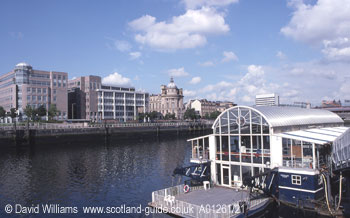By 1834 there were one hundred and thirty-four cotton mills within the Glasgow area and the development of these large economic units was just one result of the Industrial Revolution. With the harnessing of the power of coal (for producing steam), the scene was set for building large factories which had no need to be close to streams for their motive power. Thus the city expanded quickly, large factories were built and workers herded into tenement houses close to the factories in which they worked. Cotton now took the place of tobacco as the city`s great source of wealth but the fundamental difference between the two commodities was that processing cotton into cloth required the labour of many local people. New industries were built up alongside the cotton mills and these included bleaching and dyeing; in turn, these encouraged the construction of chemical works by industrialists such as Charles Tennant to provide their raw materials.
Much of the city`s production was sent overseas and this led to the enlargement
of the quays in Glasgow to the extent that by the middle of the nineteenth
century there were four kilometres (two and a half miles) of quays in
the city. The River
Clyde had been considerably deepened in order to allow ships to reach
the city centre and this, together with the demand for new ships, led
to shipyards being erected beside the river (see
picture).
Previously, the city had relied on vessels built in the Americas or in
England but now many of the Glasgow-owned vessels could be constructed
locally. Indeed, such was the expansion of shipbuilding
in Glasgow and in other Clydeside towns that in 1851 Clydeside accounted
for eighty-five percent of Britain`s total tonnage. Scotland`s iron industry
was begun in 1759 when the Carron Company began its operations near Falkirk,
and Central Scotland`s coal and ironstone industries were able to provide
the ironworks with these two vital raw materials; in turn, these factories
supplied iron, and later, steel, to the shipyards and engineering factories.
Although many of these large enterprises were spread throughout the industrial
West of Scotland, Glasgow had important coalmines within its boundaries
and a large ironworks (known as `Dixon`s Blazes`) was established in 1839
by William Dixon at Crown Street in the Gorbals; it was only demolished
in the early 1960s.
This article is based on the guidebook "The Glasgow Guide".
